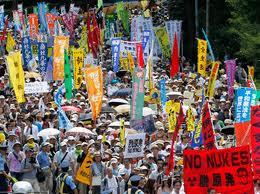Submitted by ICConline on
Since last April, a tempest of the same nature as the one initiated by the “Arab Spring”, which itself encouraged a multitude of mobilisations of “indignant” populations all over the world (Spain, Greece, United States, Canada, etc.) blew over the Japanese archipelago. And as in a good number of these movements, we again see a real blackout of the bourgeoisie and its media. In Japan itself, outside of the areas where the discontent took place, there's an identical silence. Thus, for example, a demonstration of more than 60,000 people in Tokyo, has been completely hidden from the eyes of the general public. According to the very words of an “independent” Japanese journalist, M. Uesugi, “in Japan , control of the media is worse than China and similar to Egypt”[1] .
These demonstrations, of some hundreds of people in April, rapidly growing into thousands, unfolded on a real wave of anger which got bigger and bigger. Thus, by the beginning of July, crowds from different regions (Tohoku-north-east, Island of Kyushu-south, Shikoku-south-east, Hokkaido-north, Honsu-centre-west) converged in great numbers close to the Yoyogi Park in Tokyo in order to take over the streets. Very quickly the “monster demonstration” reached close to 170,000 protesters. We've not seen such a demonstration against conditions of life in Japan since the 1970's: the last one of comparable size was against the war in Iraq in 2003.
The factor that unleashed this discontent is linked to the trauma of Fukushima, to the strong indignation faced with the lies of the Japanese authorities and their willingness to pursue a suicidal nuclear programme. The latest national plan envisages the construction of 14 new reactors from now to 2030! Following the catastrophe of Fukushima, the government has no better way of “reassuring” the population than saying: “You will not be immediately affected.. (…) It's not that serious, just like going on an aeroplane or going through an X-ray”. What cynicism! It's not surprising that the angry population asks for a “nuclear halt”, beginning with the station of Hamaoka, 120km from Nagoya, situated in a zone of considerable seismic activity.
Outside of the large numbers, which have taken the organisers themselves by surprise, we see the same dynamic role played by the internet, twitter and the new generation, particularly students and school pupils. For a good number, these are their first demonstrations. Among the almost daily protests, some have been organised by the schoolkids of Nagoya via the social networks and by a collection of anti-nuclear groups[2]. Criticism broke out throughout the web, videos spread and alternative sites swelled. A little in the image of the blog of an old worker from the Hamaoka station, denouncing the lies of the so-called “security” of the nuclear installations, spirits became animated. A student of Sendai (north-east), Mayumi Ishida, wanted a “social movement with strikes”[3]. This movement expressed in depth the accumulation of social frustrations linked to the economic crisis and brutal austerity. In this respect, the movement in Japan well and truly connects up with the other expressions of the international movement of the “indignant”.
Some very angry people didn't hesitate to speak at the assemblies, even if it's difficult to give much of an account because of the lack of precise information.
But, as in many places, this movement shows great weaknesses, notably democratic illusions and marked nationalist preconceptions. The anger rests largely channelled and hemmed in by the unions and above all, in the circumstances, by the official anti-nuclear organisations. Some locally elected critics, through their demagogy and lies, often succeeded in playing on people’s dissatisfaction, isolating them one from the other, and pushing them into sterile actions, solely focussed against such and such a project of the nuclear industry and above all against the “fusible” Prime Minister, Naoto Kan.
Despite these numerous weaknesses, this movement in Japan is symbolically very important. It not only shows that the Japanese proletariat’s relative isolation from other fractions of the class (linked to historic, geographical and cultural factors) is beginning to be overcome[4], but also that all the nauseous propaganda of the bourgeois media about the so-called “docility” of the Japanese workers rests on prejudices which are used to hold back the internationalism of the exploited.
The workers of the whole world are slowly beginning to glimpse the social force it can be in the future. Little by little, it is learning that the street is a political space that it can take over to struggle and express solidarity. In Japan as elsewhere, these are the foundations for building an international revolutionary force that can destroy capitalism and construct a society free from exploitation and its barbarities. It's a long, a very long road, but it's the only one that leads to the reign of liberty.
WH 21/7/12
[1]https://blogs.mediapart.fr/edition/japon-un-seisme-mondial/article/201111/fukushima-occuper-tokyo-des-manifestations-de-ma







 del.icio.us
del.icio.us Digg
Digg Newskicks
Newskicks Ping This!
Ping This! Favorite on Technorati
Favorite on Technorati Blinklist
Blinklist Furl
Furl Mister Wong
Mister Wong Mixx
Mixx Newsvine
Newsvine StumbleUpon
StumbleUpon Viadeo
Viadeo Icerocket
Icerocket Yahoo
Yahoo identi.ca
identi.ca Google+
Google+ Reddit
Reddit SlashDot
SlashDot Twitter
Twitter Box
Box Diigo
Diigo Facebook
Facebook Google
Google LinkedIn
LinkedIn MySpace
MySpace